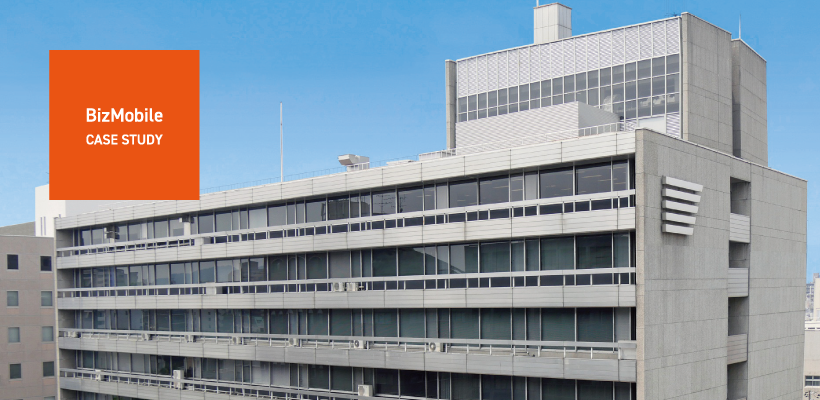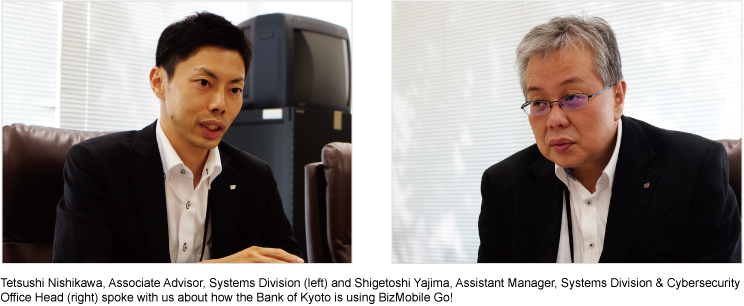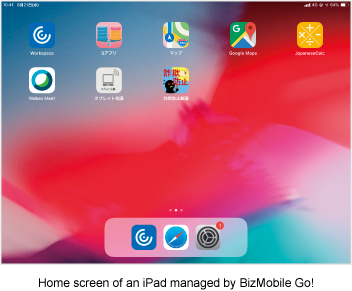CASE STUDY
Bank of Kyoto
Bank of Kyoto Uses 1,800 Tablets to Increase Customer Satisfaction and Is Among Major Regional Banks in Japan That Have Introduced BizMobile Go!
2019-12-23


Since its founding in 1941, The Bank of Kyoto Ltd. has served as a key financial institution offering a broad range of financial services to Kyoto and the surrounding area. We asked them how they use BizMobile Go! in their day-to-day operations.
Improving Business Efficiency and Customer Satisfaction With iPads
With locations in Kyoto and neighboring prefectures of Shiga, Osaka, Nara and Hyogo, as well as Tokyo and Aichi, the Bank of Kyoto is one super-regional bank in Japan that is an integral part of the everyday lives of the people living in the areas it calls home. To reduce wait times at its teller windows, the bank currently uses iPads to carry out tasks related to introducing its investment and insurance products and accepting applications for those products.

As a result, it is increasing its operational efficiency, improving customer satisfaction and further decreasing its reliance on paper. The bank also has its sales representatives take iPads with them when visiting customers to perform deposit asset-related tasks, which has also led to greater productivity. Since its employees also use the tablets for internal video conferencing and to access company systems, they have become an indispensable tool at the bank.
Seven years ago, in 2012, the Bank of Kyoto introduced 950 iPads to assist employees with sales activities. Later, as part of its Productivity Innovation Initiative, the bank significantly increased its fleet of iPads, and now boasts 1,800 of the devices currently in use.
Back when we were first considering deploying tablets seven years ago, we tried out a variety of devices. The best thing about the iPad was its usability and the fact that it was much more secure compared to Android devices. That is what led to our decision to deploy them throughout the bank. (Shigetoshi Yajima, Systems Division Assistant Manager & Cybersecurity Office Head, Bank of Kyoto Ltd.)
Watertight Security Measures That Are Right for a Financial Institution
Financial institutions need sophisticated security when introducing IT devices to their workflows. The Bank of Kyoto is no different and maintains its own bulletproof security measures. These include data encryption and using its iPads as thin clients so sensitive data does not remain on devices in the event they are lost or stolen. It also has measures in place to control access to its corporate network from outside branch offices by implementing dedicated SIMs and controlling access to branch Wi-Fi networks through SSIDs and certificates. However, even with these measures in place, the Bank of Kyoto still needed a way to remotely administer, and erase and reset (or wipe) its tablets should they become lost.
At first, it introduced an MDM offered by one of the major Japanese carriers three or four years ago. Even though no data may remain on a device when used as a thin client, something will always be left behind when it is used otherwise, says Mr. Yajima. So, we needed to be able to prevent the installation of apps besides the ones we designated, and we had to be able to remotely delete information from devices if they were lost or stolen. That made an MDM a must.
The MDM offered by the banks carrier at the time was limited in what it could manage, and it lacked the ability to distribute apps. The bank had its iPads set to reset themselves back to their initial factory state if their passcode was entered incorrectly multiple times. Every time a reset device needed to be reconfigured, or a devices apps needed to be updated, it would have to be sent to the Systems Division and connected to a PC for the necessary changes to be made. This continued even after introducing the carriers MDM.
At the time, around 20 iPads would arrive at the Systems Division every month. It took about 30 minutes to process one device, and when you consider what was involved in sending them back to the branch offices, it was costly both time and money-wise. It also caused major problems for the branch offices and sales representatives in the field, because they could not do their jobs while we were busy working on their iPads. (Tetsushi Nishikawa, Associate Advisor, Systems Division)
Switching to BizMobile Go!
Dramatically Reduces the Burden Placed on the Systems Division
Introduction of the carrier-offered MDM did little to decrease the burden placed on the Systems Division. Realizing this, the bank began to consider other MDM services. It needed one that met its needs precisely and allowed it to use its iPads as desired.
For example, we wanted to have our iPads cameras normally disabled and unusable except when necessary, says Mr. Yajima. Plus, we wanted any data taken with the camera to be saved directly on to our server and not the device. Like with e-mail, to prevent data leaks you need to keep users from being able to use a devices ordinarily convenient features in normal ways. That includes deleting unnecessary apps and only allowing the use of convenient functions when they are truly needed.
As part of switching to BizMobile Go! the banks Systems Division created different master device images for each situation the tablets would be used in, then installed the images when we upgraded our iPads.
Not only was BizMobile Go! easy to figure out how to use, but it made our job a lot simpler because it offered support for the Apple Device Enrollment Program1, which had just started service around that time, says Mr. Nishikawa. Recently, the fact that we can control our devices through BizMobile Go! has led to a real sense of security and peace of mind. And since individual stores can now reconfigure their iPads themselves, even if they have been reset, they no longer need to send them to us.
Prior to introducing BizMobile Go! the Bank of Kyoto would spend several millions of yen to have an outside company provision its iPads when it upgraded them. Now, its employees can do that job resulting in sizable savings for the bank.
1 The Device Enrollment Program is a service offered by Apple that helps businesses and The Device Enrollment Program is a service offered by Apple that helps businesses and educational institutions easily deploy iOS devices.
BizMobile Go! Brings Peace of Mind When Using Devices in New Situations or With New Apps
BizMobile Go! not only allows the bank to manage how apps are used on its iPads, but it also enables control over which network connections the devices can use. It does this by distributing individual certificates to each iPad that regulate the cellular and Wi-Fi connections that it can access, bringing further peace of mind regarding security.
Additionally, because BizMobile Go! tracks where the enrolled devices are, the Systems Division can find out where a lost iPad is and remotely erase any data that needs to be deleted, which also eliminates the possibility of losing track of the device due to factory resetting it. According to Mr. Yajima and Mr. Nishikawa, these features work together to provide the bank with a strong sense of security.

Mr. Yajima also offered his opinions about how the Bank of Kyotos use of BizMobile Go! will evolve in the future:
With societal trends like workstyle reform driving more companies to get their employees to work from home, I believe that by being able to implement strict security controls for network connections and apps using the MDM, in the future we could do the same, in addition to introducing BYOD policies. Then employees would be able to share information without having to come to the office.
It really helps that BizMobile promptly responds to our issues and requests, as well as quickly supporting new versions of iOS. We feel safe in knowing that with BizMobile Go! we can handle increases in the number of new services we use our tablets for, as well as the use of new apps.
This interview gives a good look at how the Bank of Kyoto is growing with the evolution of the Internet of Things (IoT). We would like to thank Mr. Yajima and Mr. Nishikawa for taking time from their busy schedules to speak with us. BizMobile Go! will continue to evolve into a service that meets the needs of customers.
About The Bank of Kyoto, Ltd.
Founded in 1941 as Tanwa Ginko. In 1953 it moved its main office to Kyoto City and since then, in both name and reality, has contributed to facilitating finance and the development of local industry as a regional financial institution centered in Kyoto.
The Bank of Kyoto, Ltd.
Founded : October 1, 1941
Headquarters : 700 Yakushimae-cho, Matsubara-agaru, Karasuma-dori, Shimogyo-ku, Kyoto
Total assets : JPY 9.65 trillion
Capital : JPY 42.1 billion
Representative : Nobuhiro Doi, President
Number of employees : 3,487
Number of locations : 479 (Main & branch offices: 168; sub-branches: 6; non-branch ATMs: 301;
overseas offices: 4)
Website : https://www.kyotobank.co.jp/
(as of March 31, 2019)

